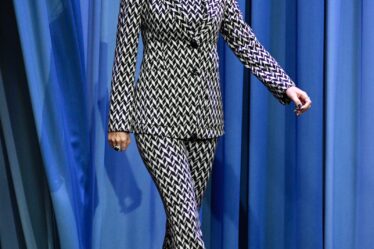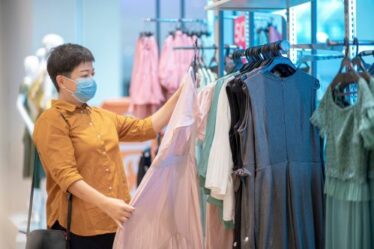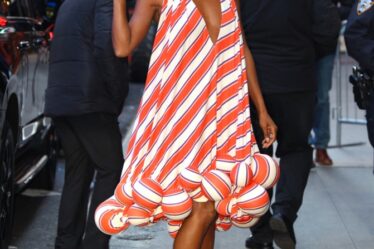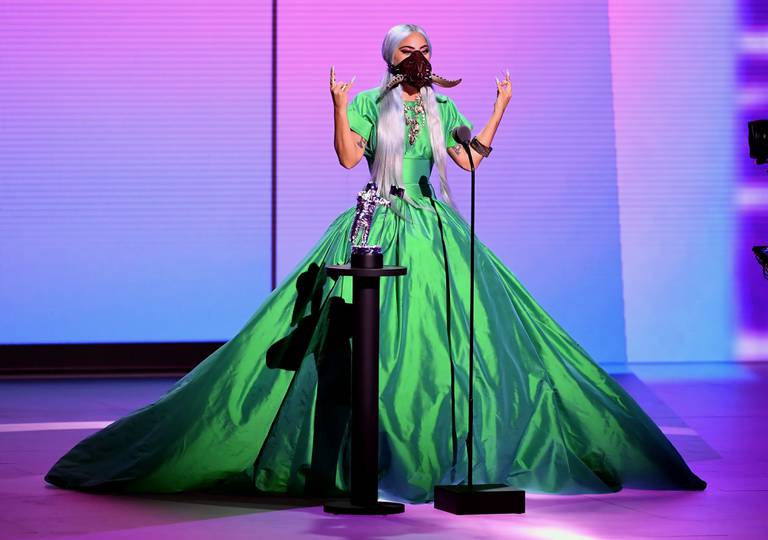
NEW YORK, United States — This summer, Christopher John Rogers was one of the most talked-about young designers on the internet. After the killing of George Floyd, when the fashion conversation on social media erupted with posts on Black designers to support, Rogers became one of the most frequently namechecked brands.
Then came a couple of major press moments in August and September: Lady Gaga accepted an MTV Music Video Award in a massive, floor-length bright green skirt and top he designed. A few weeks later, he won the CFDA Award for emerging designer, and then Zendaya won an Emmy wearing his voluminous taffeta black and purple gown. The volume of social media content mentioning the brand more than doubled over the summer months when compared to earlier in the spring, according to analytics firm Tribe Dynamics.
Rogers is a 27-year-old American designer who grew up in Baton Rouge, Louisiana, and graduated from Savannah College of Art and Design (SCAD) in 2016. While interest in his label soared in 2020, it was a celebrity stylist and Instagram favourite long before it hit stores this February. He had already dressed Michelle Obama, Lizzo and Tracee Ellis Ross way before he won the CFDA/Vogue Fashion Fund in November 2019.
Lady Gaga wears Christopher John Rogers during the 2020 MTV Video Music Awards | Source: Kevin Winter/Getty Images for MTV
So, for Rogers, the focus on his race felt hollow, especially since much of the attention came from people who “didn’t really identify with the brand who were all of sudden saying we were their favourite Black-owned brand,” he said.
His discomfort reflects the complicated status many Black designers feel. They don’t want to be defined by their racial identity, and yet the industry often sees them this way.
“I’m always inspired by my life, and it’s through the lens of someone who happens to be Black, but it’s definitely not Black work,” said Rogers.
When more retailers reached out in recent months, interested in carrying his collections because he was a Black designer, and not because the collection would appeal to their customers, Rogers declined.
“Don’t buy me because you need to have a Black designer on your roster,” he said. “But that actually never even is a concern. The concern is: do you get the work? And if you flatten it, and if you can’t see it in its fullness, then the brand isn’t for you.”
Don’t buy me because you need to have a Black designer on your roster.
Rogers’ comments reflect his approach to the fashion business so far. Despite the increased attention, Rogers wants to grow slowly and carefully and is not desperate to work with retailers or partners who want to push him in a different direction.
From a distance, Rogers knows his brand looks like an overnight success, but he said the last four years have felt long. That said, he’s in no rush. He and his business partners and former classmates — Brand Director Christina Ripley, Studio Director David Rivera and Production Director Alexandra Tyson — “realised that it’s okay to sort of completely be an anomaly in that respect and take your time,” he said. “We could have 20 stores, but that also would mean chaos and lower quality and mistakes made.”
The Right Fit
It’s only been about a month since Rogers’ latest collection reached Sherri McMullen’s namesake store in Oakland, Calif., and most of the pieces have already sold out. The first to go? The $2,275 voluminous black and purple taffeta dress with a wide waistband that Zendaya wore, which the retailer described as the follow up to the “strawberry dress” Rogers designed a year earlier — and first attracted McMullen to the label.
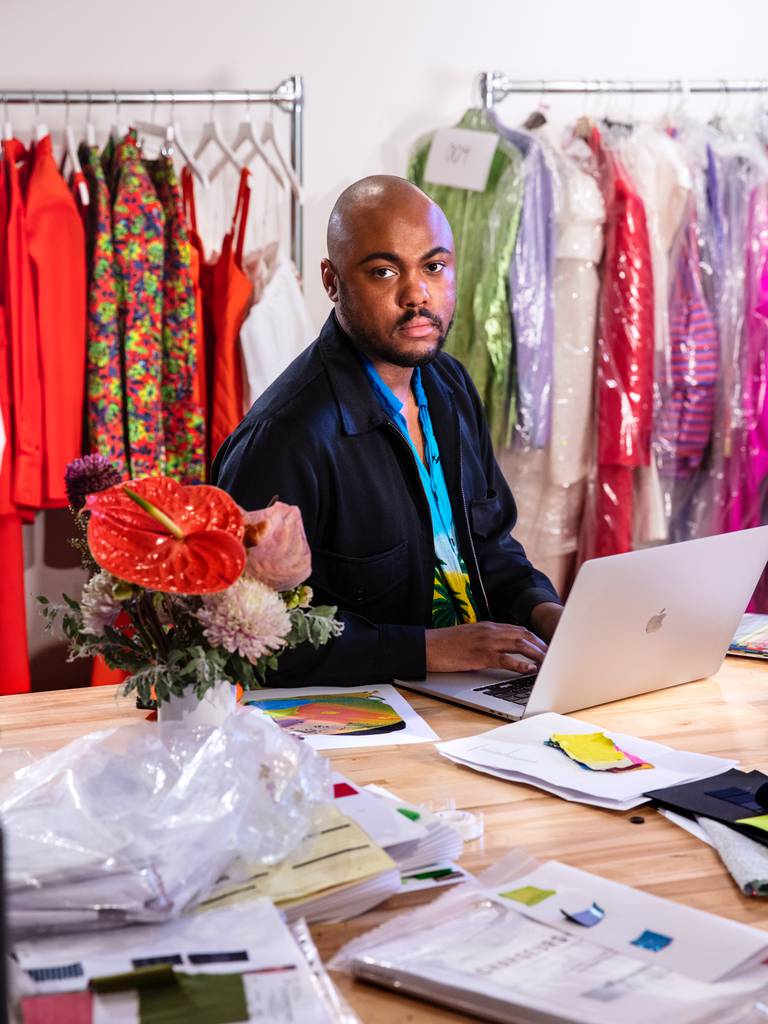
Christopher John Rogers | Photo: Elliott Jerome Brown Jr. for BoF
“One day, this dress is going to be at the Met,” said McMullen, who is doubling her order in overall dollars from Rogers for Spring/Summer 2021. Her shop is one of the few places, along with Net-a-Porter, Bergdorf Goodman and Joyce Hong Kong, where anyone can buy Rogers’ pieces this season.
Rogers made his debut at New York Fashion Week in September 2018 and quickly picked up a roster of fans among celebrity stylists. But his brand didn’t launch with retailers until the Spring/Summer 2020 season — after he had already dressed Michelle Obama, Cardi B and Lizzo, after he won the CFDA /Vogue Fashion Fund and after he had established an aesthetic identity of big volume and bright colour for his label.
“What stood out to me was the exuberance of the fabrics… the colour combinations that he chooses,” said writer and philanthropist Suzanne McFayden, a customer through McMullen. “As a Black woman it’s very important to me who find emerging Black designers who are talented — I don’t just buy because they are Black — but who are talented and have something to say.”
McFayden’s purchases from the Spring/Summer collection arrived after the pandemic lockdowns began where she lives in Austin, Texas, but she dressed up at home with some of the pieces for Instagram. “It just makes me feel happy,” she said, echoing the sense of joy other customers said they feel wearing Rogers’ clothes.
“It’s so rare that something looks special but also fits so well,” said Abigail Stern Tananbaum, founder of apparel company Matek, who commissioned a custom, monochromatic hot pink pants and strapless corset feather emblazoned top from Rogers for her wedding in 2019. “It was so much good drama.”
McMullen said Rogers also stands out for designing for women’s real bodies, and described his customer as a woman who is “very confident in her style, but also in her life, as well.”
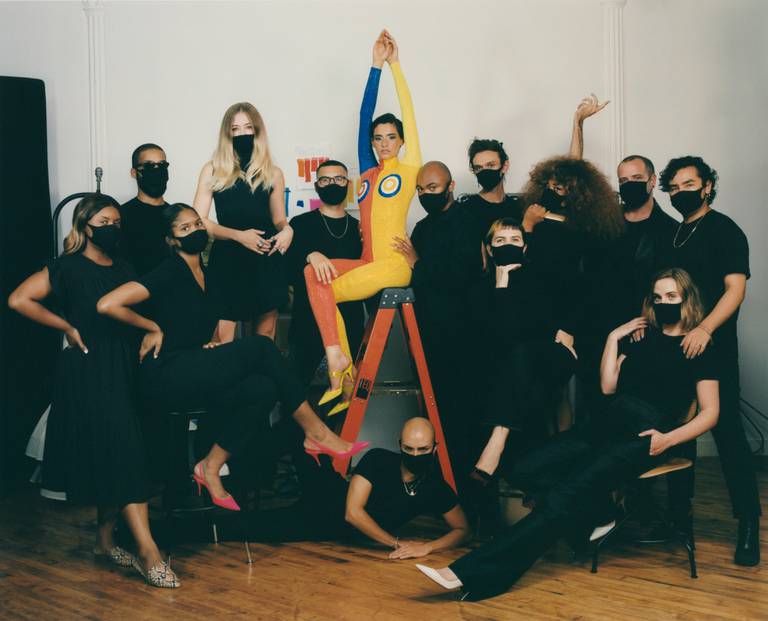
Christopher John Rogers and his team in the spring 2021 campaign | Source: Alexander Saladrigas
A Deliberate Approach
Tory Burch Chief Executive Officer Pierre-Yves Roussel, who has been mentoring Rogers since the Fashion Fund at the request of Vogue‘s Anna Wintour, credited Rogers’ and his team’s thoughtful approach to building the business as well as the designer’s charismatic personality as strengths. “He has his own aesthetics, he has his own personality and he is really truly creative,” he said.
Roussel is also impressed by the visual impact of Rogers’ sense of colour and shape in his designs. “The way he is picturing his creation works very well online and in the digital world, which is super important,” he said.
Next on Rogers’ to-do list is launching a proper e-commerce site, going live Friday, where shoppers will be able to pre-order the Spring/Summer 2021 collection, directly with him. After that, he has some collaborations with larger brands in the works, as well as special products for the website at a lower price point.
“I don’t need to have 30 stores [in] my second season to survive,” he said. “It’s okay to grow with the four or five that we have because they get what we’re saying. And they can actually, you know, sell the clothes.”
Origins
It’s not a mentality he had four years ago, when Rogers was a fresh graduate from SCAD, hoping to turn his award-winning senior collection of six looks into the foundation of his own fashion business, a dream since he was a kid growing up in Baton Rouge.
Rogers sent out a line sheet retailers, set up a GoFundMe to raise money to produce the samples, but there was no interest from buyers. He set up an e-commerce site for a collection after graduation, and sold one T-shirt.
I don’t need to have 30 stores in my second season to survive.
Rogers decided to move to New York City anyway, where he waited tables until he managed to land a job designing knitwear at Diane von Furstenberg in January 2017, as former creative director Jonathan Saunders was getting settled there.
It took a few months, but Rogers saved enough money to buy a sewing machine and fabric and soon got back to work on his own line in his free time. Friends and business partners Rivera and Tyson pitched in with cutting, pattern making and sewing, and Ripley started to formulate an ambitious business and marketing plan.
“We were kind of naive, but at least we were like trying to do something real legitimate and not just play around,” Rogers said.
The next season, Rivera encouraged Rogers to present a collection during New York Fashion Week for the first time, and thanks to the generosity of Ebony L. Haynes, former director of the Martos Gallery, landed a free venue. Rogers spent just $2,000 on production costs.
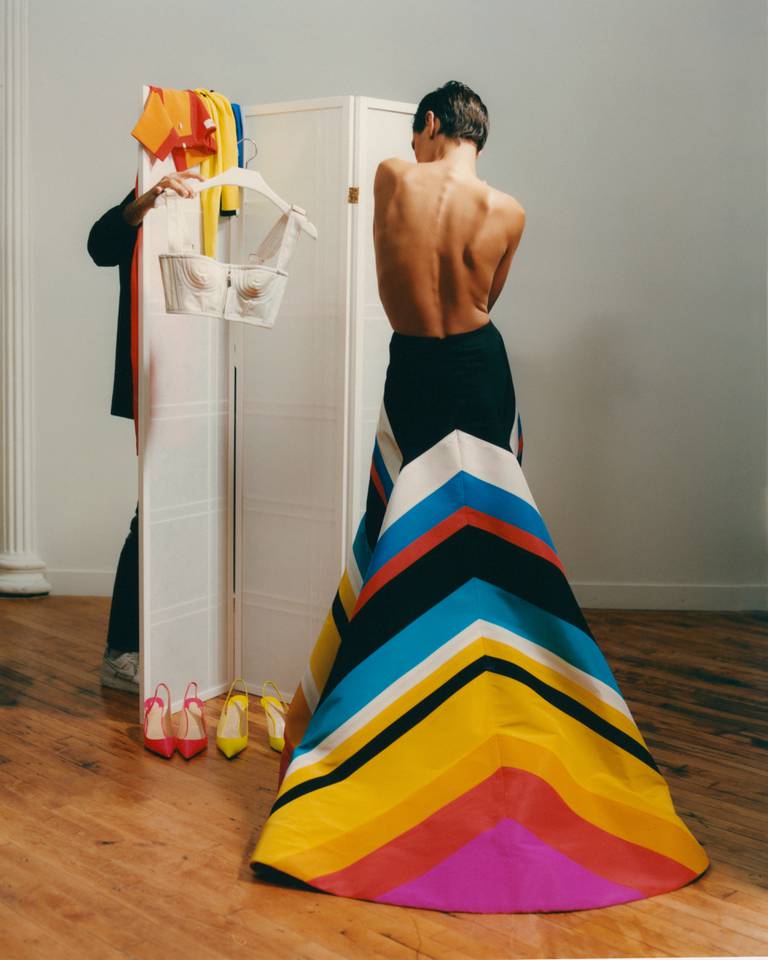
Christopher John Rogers Spring 2021 campaign | Source: Alexander Saladrigas
Leading industry voices like The Washington Post‘s Robin Givhan wrote about it, and Rogers and his team met with many of the buyers they had dreamed of working with: Barneys New York, Browns, Net-a-Porter, Harvey Nichols. The retailers didn’t bite. At that point, with the exception of the suits, Rogers and his team were still making everything by hand, and stores were worried about their ability to produce. Meanwhile, Rogers and his team still had their full-time jobs that they, too, worried about juggling at the same time.
No Safety Net
The next season, Rogers again presented during fashion week and again met with a formidable roster of stores. Forty Five Ten was interested in buying the collection, Rogers said, but the selection was too small to be worth producing for the designer.
“So just because someone places an order doesn’t mean you need to accept it,” said Rogers. This was especially important for him because, at the time, he had no financial safety net. “Literally only this year have I ever had money in my savings account.”
A few months after presenting his Fall 2019 collection, Rogers was laid off from DVF.
It was a scary and stressful time, but also ended up being a blessing. He was accepted as a competitor in the CFDA/Vogue Fashion Fund, and in retrospect would not have had the time to work on the required challenges if he was still working. To pay the bills that summer and pay for the label’s next collection, he landed a freelance design job through a friend.
So when IMG came calling for New York Fashion Week with a free space at Spring Studios for the first real runway show, Rogers was ready to take that leap, too, and finally, Rogers was in business. Net-a-Porter picked his label up as part of its Vanguard emerging designer program, which comes with support and mentoring for designers. McMullen and Forty Five Ten bought in as well.
Then came a much-needed cash infusion. Rogers won the Fashion Fund, which came with a $400,000 cash prize that he used to pay himself and his team their first salary, and finally rent a studio space in Soho, as well as working capital.
Production of the first collection was very stressful, he said. Rogers and his team were still sewing most of the pieces by hand at that point, so they had little experience navigating the Garment District.
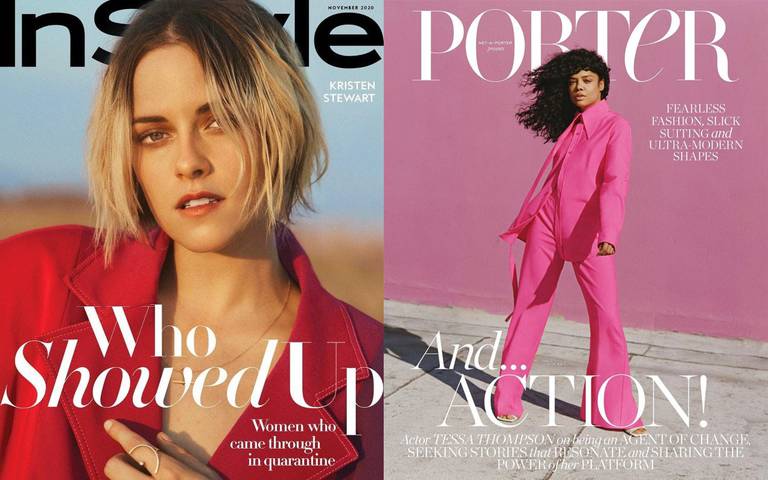
Christopher John Rogers worn by Kristen Stewart and Tessa Thompson on recent covers of InStyle and Porter | Source: Courtesy
“I had never sort of done something on that scale,” he said. “Starting those relationships with people and having them take you seriously and not put you at the end of the line is really difficult — especially when you aren’t doing 100 units of something.” Rogers learned to be nimble and communicate with his retail partners.
Looking Ahead
Throughout these ups and downs, Rogers realised the virtue and value of staying small despite the pressure to capitalise on the attention that comes with, for example, dressing Zendaya for the Emmy Awards in September when his brand generated more than $1.6 million in earned media value. “People have been asking so much about [that dress],” he said.
McMullen said she often sees young designers go into a different direction, aesthetically, because of external pressure from major retailers. “He has a very strong point of view and he is staying to that,” she said,” which is also really refreshing to see.”
Rogers knows his customer is not a “fantasy 25-year-old who has a million dollars,” but a woman in her forties, fifties or sixties who is willing to wait for something special.
“I paid attention a lot to designers that I love, and maybe how they haven’t always succeeded, based on some of the choices that they’ve made,” he said. “What we have always done and will continue to do is just make really great clothes that we believe in.”
Related Articles:

